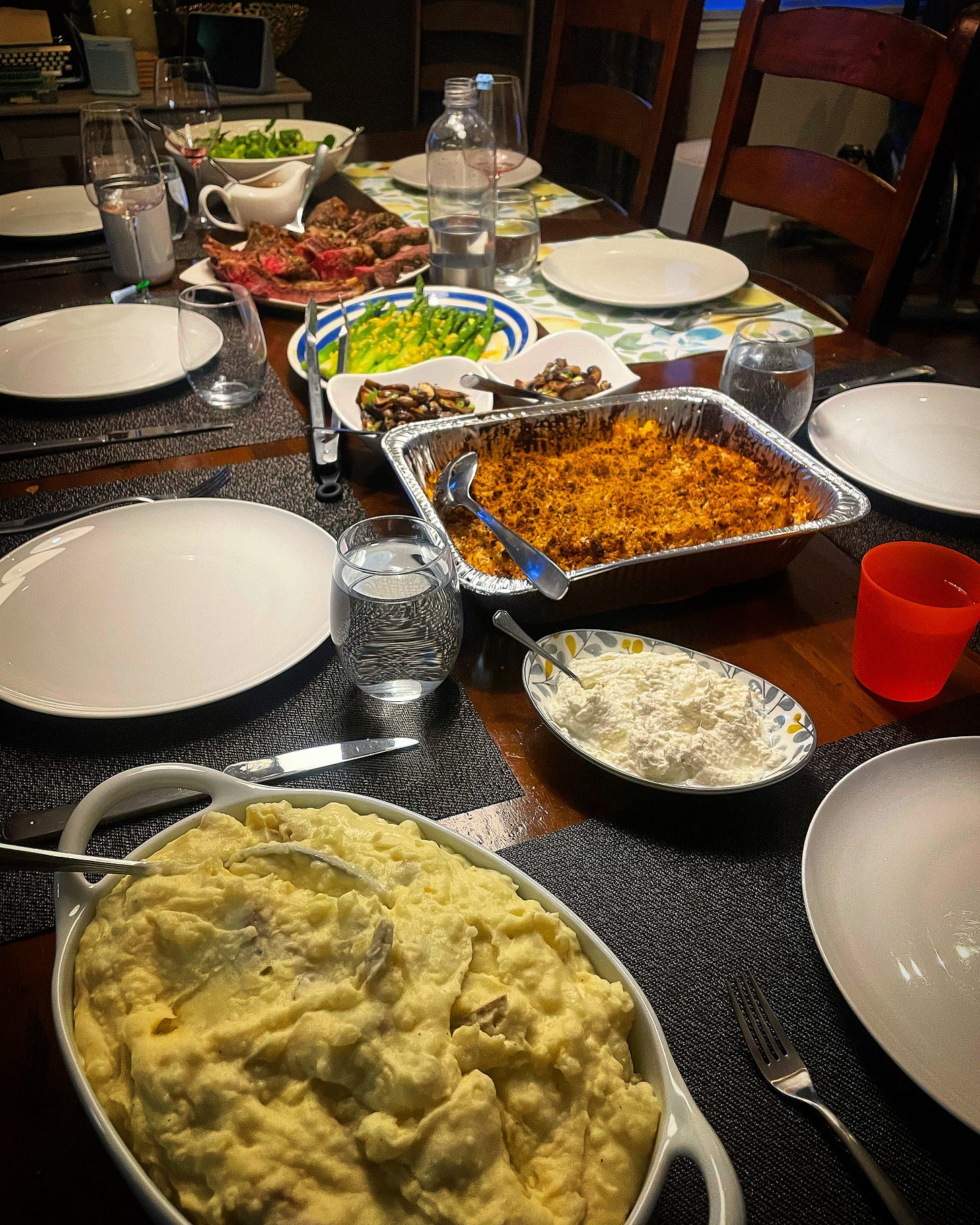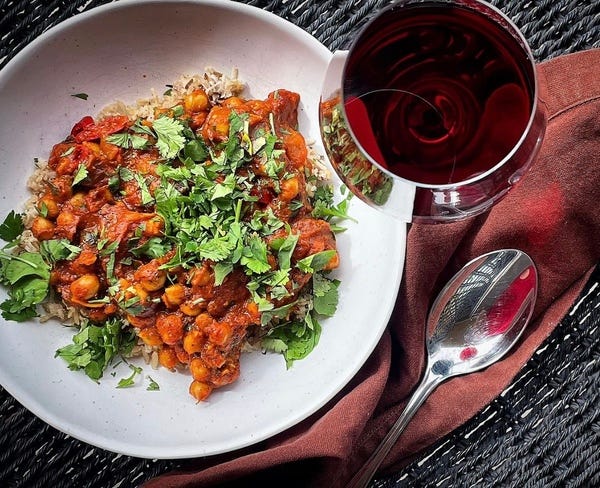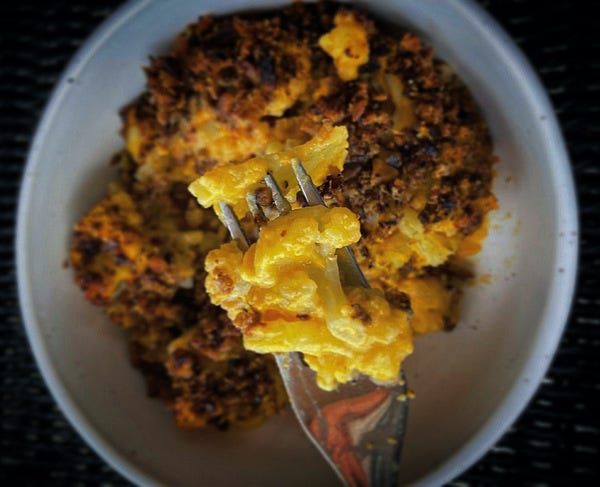I Lie for My Family's Benefit.
A sneaky, cheesy gratin, the wines to pair with it, and an early spring cocktail for celebrating.
I’m a liar.
I wish I wasn’t. I wouldn’t if I didn’t have to, but extenuating circumstances force me to lie.
You see, I have a few finicky eaters in my family. My 13-year-old nephew, who, somewhat ironically, loves the bold flavours of Thailand and Vietnam, the slippery noodles of Japan, and the rich spices of Mexico, weirdly refuses to eat mushrooms, sweet potatoes, olives, most cheeses, or anything creamy.
My parents, darling people that they are, are your basic meat-and-potatoes eaters. They are highly suspect of arugula, don’t like basil, and absolutely refuse anything labelled “vegan,” “plant based,” or “vegetarian.” Or… so they claim.
Last weekend, for a birthday dinner celebrating both my dad and my niece who were born a week apart (and many, many decades), I made a very tasty, cheesy cauliflower gratin. Everyone, including my nephew, heaped seconds onto their plates – and my parents requested the leftovers to take home. (The recipe is below.)
I can’t get a better or more flattering compliment than the people I love losing all decorum and plunging their forks straight into the serving bowl for just one more bite, long after claiming they are full. So I couldn’t, and my ego wouldn’t let me, tell my beloved family the truth.
My cheesy cauliflower gratin is vegan.
I’m not vegan. I’m not even vegetarian. But I do love vegetables and have no objections to plant-based meals; in fact, I quite enjoy doing so. I found this recipe for cauliflower “mac” and cheese three years ago on Love and Lemons’ outstanding blog and have been making it ever since. I’ve included the recipe, with my very minor tweaks, below.
The gratin fits in neatly with my hosting ethos: easily made ahead, this casserole is broiled in under 10 minutes, just before serving. It can be adjusted to the size of your crowd, and you can make it as a vegan main, or, as I did, a side to a larger menu. Our dinner included a stunning reverse-sear, bone-in prime rib, sautéed mushrooms, mashed potatoes, jus, asparagus with preserved lemon, and salad.
Earlier in the day, having just assembled the gratin, I texted my sister, worried the rest of the family would reject it outright.
“I think this cauliflower is delicious,” I wrote. “But I don’t think anyone else will.”
“Don’t tell anyone what’s in it,” she responded.
Some internet philosophers have suggested omissions are lies. Well, I suppose I am guilty of that as well. But my sister told me to.
She was right and I needn’t have worried. My family dug in with gusto.
I was asked a few times over dinner what was in the gratin, which I topped with a mix of panko, nutritional yeast, finely chopped toasted walnuts and chili pepper flakes. Each time, I evaded answering as skillfully as an Italian waiter dodging a recipe request from a tourist. (This actually happened to me in Maranello. I had a mind-blowing pasta at Ristorante Montana, near the Ferrari Museum. I asked about the preparation, and, with a vague wave of his hand, the skillful waiter began listing, “carota, cipolla, crema …” and wandered away, his voice trailing off behind him.)
I will eventually tell my mother. Not to crow about how I pulled one over on her, but to come clean, and maybe, just maybe, surprise and delight my parents with the idea that “vegan food” is just food and can be – and is – delicious.
I won’t tell my nephew.
Wines for Plant Based Meals
You pair wine to a vegetarian meal just as you would a meat-laden one. And that is to say, you don’t look to the vegetable, or the tofu, or the pasta; instead, you consider the preparation, spices, and sauces, and go from there.
For creamy, cheesy preparations, such as fettuccini Alfredo, potato and leek soup, or my cauliflower gratin, you can either choose to compliment the rich flavours with a buttery white wine such as a Chardonnay, or, as is often my preference, contrast the richness of the dish with a bright and juicy wine with a bright streak of mouthwaterig acidity. Depending on specific flavours making up your menu, Pinot Noir, Gamay, and lighter bodied Cabernet Franc, like those from France’s Loire region, fit the bill.
Try: Vaucher Père et Fils 2022, Beaujolais, Burgundy, France $20.95 #534339
We tried this at a tasting I was hosting on food and wine pairings. The chef had created a remarkably impressive grain risotto, inspired by an old Scandinavian recipe that was somewhat uncharitably called “Nordic grains porridge” which sounded uninspiring to say the least. But it was creamy and earthy and utterly delicious and worked brilliantly with this medium-bodied Gamay which has flavours of earthy spice alongside tart red fruit.
For light and bright recipes that put the vegetables upfront, such as garden salads, pasta primavera, or stir-fry’s, go with a savoury wine with verdant flavours of herbs. Sauvignon Blanc, Grüner Veltliner, Vermentino, or Verdicchio are all nice choices.
Try: Prelius Vermentino 2022 Tuscany, Italy $23.95 #36317
Vermentino has been around for a long time, but is just gaining popularity again. A light-to-medium bodied Italian white wine with saline minerality, green apple and lime zest flavours, sometimes white peach or floral, and a pleasing bitter almond finish, Vermentino can fall into the same taste and style category as Sauvignon Blanc or Grüner Veltliner. Fresh with snappy acidity, these are terrific spring wines for outdoor sipping.
For deeply flavoured, “meaty” dishes, like mushroom stew, eggplant involtini, or mild bean dishes, such as lentil soup or mild refried beans, you can bust out your bigger reds – especially if your meal has some char flavours from the grill. Go for smoother red wines with restrained tannin as the food likely doesn’t have the fat and protein to calm aggressive tannic structure. Wines like California Merlot or Zinfandel, Argentinian Malbec, or South African Pinotage could be very satisfying, indeed.
Try: J. Lohr “Hilltop” Cabernet Sauvignon 2021, Paso Robles, California, USA $49.95 #686584
Red wines with plush texture are a boon for vegetarians who might have mourned the loss of enjoying the Big Red experiences. True, wines with fierce and firm tannins will clobber meals that don’t luxuriate in dense proteins and rich fat, but full bodied reds that keep tannins soft can work very well with denser, plant-based meals.
For recipes with bold spice and tingling heat, you need to offset the fire with low alcohol and a touch of sweetness. Otherwise you risk aggravating your mouth to the point of not tasting anything at all, and where’s the fun in that? If you’re working with hot Italian (faux) sausages or tomato-based spicy sauce, a fruity, low-tannin red like basic Valpolicella could work. If your sauce is more like a tomatillo salsa that’s spiked with serrano chili, a flavourful gochujang, or aromatic, Thai green curry, you might be better off with a fruit-forward white or sparkling wine. Prosecco, Alsatian Pinot Gris, or an off-dry Vouvray (Chenin Blanc from Loire) are all good examples.
Try: Domaines Schlumberger Kessler Pinot Gris 2019 Alsace, France $38 #249623
Listen up, wine lovers: just because a wine has residual sweetness (and in the case of Domaines Schlumberger it’s 30 grams per litre), does not necessarily mean it’s cloying or gloppy. It all comes down to balance of acidity. (As I always tell my wine students, no one will drink a glass of pure lemon juice, nor a glass of pure sugar, but mix the two together, and you have something quite inviting.) So when pairing an off-dry (slightly sweet) wine to your dinner, you’re not stuck with something in the vicinity of dessert wine. A wine with a soupçon of sweetness, balanced by lip-smacking acidity is very enjoyable.
A Cocktail for Spring Celebrations
The first six months of the year contain the birthdays for everyone in my family, as well as my close friends. March alone celebrates the birthdays of my mum, dad, and niece, and this year, we’re adding an early Easter to the party circuit.
I always like to start a soirée with a welcome cocktail to set the tone for the evening. And thanks to the mercifully mild winter Toronto is experiencing, I’m in the mood for lighter spirits, gin being a fave.
I usually don’t break out the gimlets until May, but seeing as I’m writing this with the windows cracked open and the sunlight streaming in, I can’t see how I can delay it any longer.
Serves: 1
Bartender level: moderate
Ingredients:
• Handful fresh basil leaves, plus more for garnish
• 3-4 thick slices cucumber, plus more for garnish
• 2 oz gin
• 1 oz fresh lime juice
• 1 oz simple syrup
How to Make It:
1. Into an empty shaker add basil and cucumber and middle to release juices.
2. Add ice, gin, lime juice, and simple syrup and shake well to combine.
3. Strain into an ice filled tumbler, garnish with a basil leaf and cucumber slice.
4. Enjoy on a sunny patio!
Vegan Cauliflower Gratin
I saved this Love and Lemons recipe in my “faves” folder with the note “this was excellent.”
I’ve tweaked the smallest details to tailor to my tastes – as I expect you will if you try this. But I didn’t change enough to claim it as “my” recipe, and besides, my old school journalism training immediately starts triggering my left eye to twitch at the slightest whiff of potential plagiarism.
Makes: 1 9x13 pan
Chef level: easy
Special equipment: high-powered blender or Nutribullet
Ingredients:
2 small-medium heads of cauliflower, broken into bite-sized florets
3/4 cup cooked sweet potato
3/4 cup cooked Yukon Gold potato
1/4 cup olive oil
1/2 cup water
7 Tbsp nutritional yeast, divided
1 1/2 Tbsp apple cider vinegar
1 Tbsp onion powder
2 cloves garlic, peeled and lightly crushed
1 tsp smoked paprika
1/4 tsp cayenne, optional, to taste
1/2 roasted red pepper
1 Tbsp soy sauce
1 tsp tumeric
1/4 cup cashews, soaked for about two hours
1/2 cup panko
1/4 cup toasted walnuts chopped into a very fine crumb
1 Tbsp chili flakes, optional, to taste
How to Make It:
Set a large pot of water on to boil. When ready gently salt the water and add the florets cooking until just soft, about 5-10 minutes depending on size.
Meanwhile add the cooked sweet potato through cashews (using only 4 Tbsp of the nutritional yeast) to a high-powered blender, and whiz to combine into a smooth, pourable, sauce. You may have to do this in batches.
In a 9x13 casserole pan, combine the cooked cauliflower and “cheese” sauce.
Mix the panko, walnuts, and remaining nutritional yeast and spread in an even layer over the top of the cauliflower.
Broil at 450°F for 5-10 minutes until the top is toasted.
Make Ahead:
Can be made up to step 3 a day ahead of time. Keep the panko topping stored separately from the cauliflower, leaving both covered in the fridge until needed.
Spring Cleaning
Renovations have started at Quaintrelle HQ – otherwise known as my home.
It’s simultaneously an exciting time as well as a stressful one. I’m behind on this newsletter because my day was disrupted yesterday by the unexpected rearranging of wine glasses and plates and tchotchkes long forgotten about (I found a coupon to HMV that expired in 2007 filed along with my Zellers credit card – sorry to the non-Canadians for the inside baseball, very Canadiana cultural references.)
The first domino to fall in this round of construction is the installation of a new hutch. It will be a marvellous entertaining piece when all is done and dusted, but yesterday was upended to that very dusting.
Luckily, I host enough that my collection is generally always in use. For those that fall to the back of the cupboard, I’m Type A enough to set aside some time at least once each season to steam-clean my stemware, and my years spent in restaurants mean I can blaze through a dozen wine glasses in no time. Despite this, there I was polishing away, when really, I needed to be writing.
If this inspires, reminds, or triggers you to get washing your own wine glasses before Easter/Passover/Mother’s Day celebrations set in, I put together a video for The Wine Sisters on how to get it done quickly and without opening a vein. It has accumulated more than 2,000 views on You Tube.
And I would be remiss if I didn’t mention that Wine School tickets are on sale. Many of you have arrived here via The Wine Sisters, so you already know of this, but some of you are not connected to TWS at all, and may not realize I lead interactive wine tastings Wednesday evenings downtown Toronto. If that piques your interest, please see the class schedule and register here.
In the meantime I’d love to know if you have ever lived through renos and, if so, your words of wisdom for surviving it. What would you do differently? What would you keep the same?
xo –
Erin










